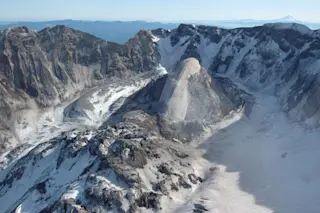The new dome forming in the crater of St. Helens, seen during activity in February 2005. The volcano has been quiet since 2008. Image: USGS/CVO. Today I have updates on two volcanoes that are monitored by the US Geological Survey -- one you've all heard of and one that was a surprise even to me. St. Helens, Washington The Cascades Volcano Observatory released an information statement this week about the current status of activity at the most active volcano in the lower 48 states, Mount St. Helens. The volcano in southern Washington has been quiet since the last eruptive period ended in 2008 following four years of dome growth within the 1980 crater. However, just because a volcano isn't erupting doesn't mean that there aren't things happening within the magmatic system below the volcano. The USGS reports that the volcano has slowly been inflating during this period since the 2004-08 ...
U.S. Eruption Update for May 1, 2014: New Magma Under St. Helens and Possible Submarine Eruption in the Mariana Islands
St. Helens volcano activity has been quiet since 2008, but magma is slowly refilling below its surface, indicating potential future eruptions.
More on Discover
Stay Curious
SubscribeTo The Magazine
Save up to 40% off the cover price when you subscribe to Discover magazine.
Subscribe













